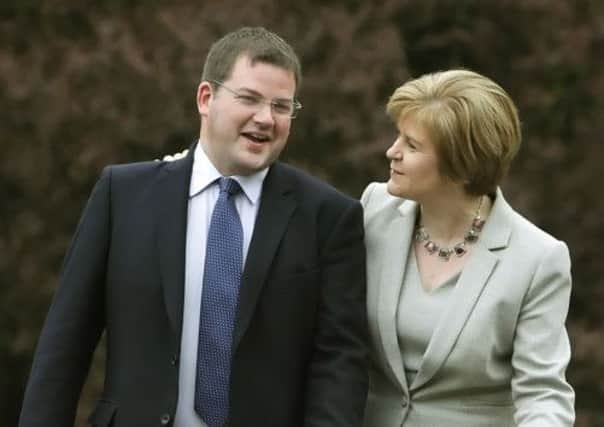Euan McColm: Swings and roundabouts of Scottish politics


Scottish Labour may not have been able to overtake the SNP in the seat – left vacant by the death of Nationalist MSP Brian Adam in April – but a decent shift of 9 per cent towards the party provided some comfort.
The SNP, on the other hand, rubbished the scale of its opponents’ progress. If Labour can’t defeat my party in a by election half-way through its second term in government, taunted Deputy First Minister Nicola Sturgeon, then it’s made precious little progress.
Advertisement
Hide AdAdvertisement
Hide AdSo, it’s clear, then: listen to Labour and it’s on the up, listen to the SNP and Holyrood’s principal opposition party is a long way from returning to the government benches.
The truth lies, as is so often the case, somewhere in between those two contradictory positions.
There was never any doubt that SNP candidate Mark McDonald – who resigned as a list MSP for the North-east of Scotland in order to fight the by-election – was going to win the seat. His predecessor, having won by fewer than 500 votes in 2003, steadily built his majority until he left Labour trailing by 7,175 in 2011.
To record that thumping majority, Adam took 55 per cent of the vote two years ago. On Thursday, McDonald had to content himself with a still respectable 42 per cent.
Labour’s Willie Young increased his party’s share of the vote from 28 to 33 per cent. It was modest progress, but progress nonetheless. It’s worth reminding ourselves just how desperately bleak things looked for Labour in 2011. The SNP’s overall majority in the Scottish Parliamentary elections was a devastating blow to a party still struggling to come to terms with Alex Salmond’s first Holyrood victory four years earlier.
On taking over as leader, Johann Lamont’s priority wasn’t some unrealistic, swift comeback, it was keeping her party alive. Certainly, that 9 per cent swing in Donside suggests that Scottish Labour still has a pulse, and it’s getting stronger. Given where it was such a short time ago, the party is lifted by the result.
Sturgeon’s pointed dig may find soft Labour flesh to pierce – of course, an opposition with any momentum towards the return to power should be expecting to win a by-election, rather than reduce the degree of loss – but the numbers don’t make great reading for the SNP.
While the Nationalists’ share of the vote dropped more than 13 per cent and Labour’s rose almost five, turnout fell, from 47 per cent in May 2011 to 38 per cent on Thursday. That impacted on all parties, but the SNP took by far the largest hit, losing more than 5,000 votes since the last election.
Advertisement
Hide AdAdvertisement
Hide AdYes, it’s a by-election and those can be a dreadful inconvenience to voters, but the SNP threw everything at this constituency and didn’t particularly stir the electorate, which was far more interested in who might work to reduce congestion at the Haudagain Roundabout than in matters constitutional.
The Nationalists – and their YesScotland campaign – will be troubled by such a lack of voter interest. If the SNP is to have a chance of winning next September’s independence referendum, it has to persuade those who gave them a chance to govern (and a good many more) to take another leap of faith. The dwindling support suggests that necessary passion for independence is not yet ignited.
To win the 2016 Holyrood election, Labour would have to do as well – across the country – as it did in Donside on Thursday. To get anywhere near its dream of winning the independence referendum next year, the SNP has a higher mountain to climb. Yes Scotland campaigners may claim they’re playing the “long game”, building towards victory a year in September, but the Donside result doesn’t bear that analysis out. A slip in SNP support – when backing for independence remains stuck below 30 per cent – is terrible news.
SNP spin is that this was an election about sharp constituency issues in which Labour should have done considerably better. But can the Nationalists’ really believe that the independence question didn’t come in to play in Donside?
Local campaigning may have concentrated on that roundabout – and some controversial plans over school closures – but the by-election was held against a backdrop of a national debate focused entirely on next year’s referendum. And, when it came to that key SNP policy, voters weren’t excited.
Where next for both parties, then? Well, the avoidance of humiliation allows Johann Lamont – if she can find the stomach for it – to carry out her frequently postponed reshuffle without it appearing to be a defensive measure. Her front-bench remains uneven, with shadow Finance Secretary Ken Macintosh a weak link, and a freshened-up team would be to Labour’s advantage.
For the SNP, the problem remains the same: how does the party convince those voters, who’re happy to see them run a devolved government, to take the relationship further?
MSP’s will return to the Holyrood debating chamber in September and the independence referendum white paper will follow soon after. Labour is outwardly cocky at the prospect, while privately worrying that – just as he managed in the 2011 Holyrood election – Alex Salmond will bring the people with him at the 11th hour. The SNP is equally confident in public – but even more twitchy in private.
Advertisement
Hide AdAdvertisement
Hide AdAberdeen Donside failed to give the referendum campaign the boost it so dearly needs. On the swings and roundabouts of Scottish politics, the scale of Labour’s defeat on Thursday is no cause for celebration among SNP members. «
Twitter: @euanmccolm